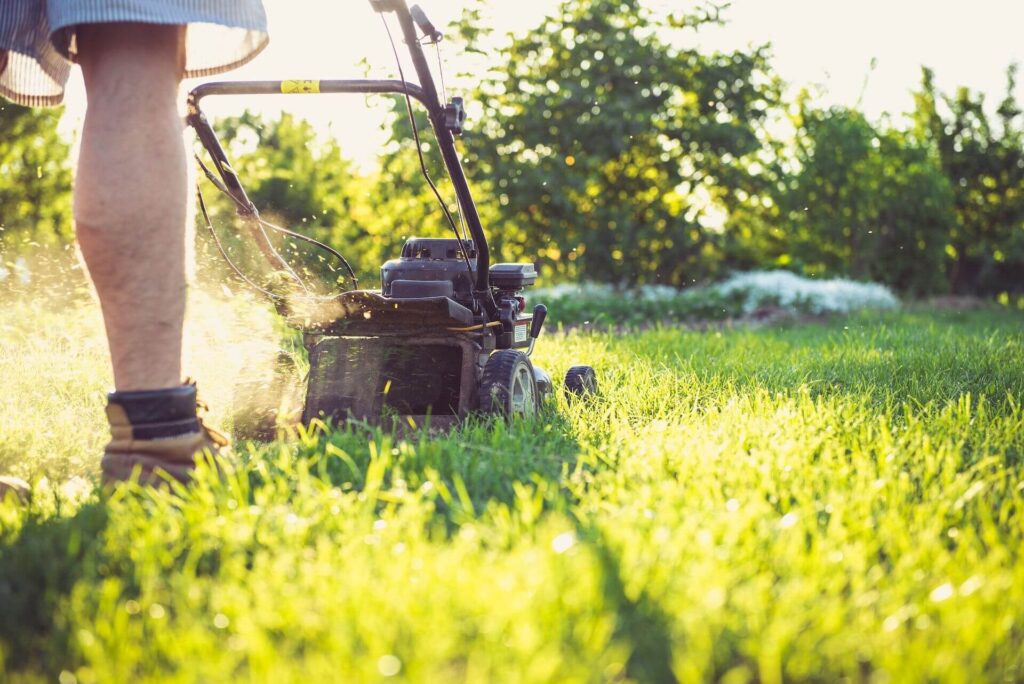Regardless of how long you’ve been in Colorado you’ve most likely learned one thing; Colorado’s finicky weather and stubborn clay soil can make it frustrating to get a lush green lawn. And while we spend a lot of time talking about what’s happening above the ground—like mowing, watering, and fertilizing—the real magic (or mischief) happens beneath the surface.
That’s where soil testing comes in. Colorado’s soil is… let’s just say “unique.” Between our naturally high pH levels, clay-heavy composition, and low organic matter, it’s easy for even well-tended lawns to struggle. Add in regionally inconsistent precipitation, newer home developments with disturbed soil, your lawn may be trying to grow in less-than-ideal conditions.
Soil testing is important because it removes the guesswork. Instead of blindly applying fertilizers or adjusting your watering schedule, a soil test can give you real, science-backed insights into what your lawn actually needs.
Armed with this info, you can create a personalized lawn care plan tailored to your yard’s exact conditions—saving money, water, and frustration in the process.
🌿 So… What Is a Soil Test, Really?
A soil test is like a wellness check-up for your lawn. It tells you what’s going on underground — which, as it turns out, is where all the real action happens. Grass health, root development, water absorption, and nutrient availability all depend on what’s going on in your soil. If your soil is out of balance, your lawn won’t thrive—no matter how much you mow or water.
At its simplest, a soil test evaluates:
- Soil pH – Is your soil acidic, neutral, or alkaline? This affects how well your grass can absorb nutrients. In Colorado, soils tend to be alkaline (otherwise known as ‘basic’), which can lock up nutrients and stunt growth.
- Macronutrients – These are the “big three” your lawn needs: nitrogen (N) for green growth, phosphorus (P) for roots, and potassium (K) for resilience and disease resistance.
- Micronutrients – Think of these as the vitamins of soil health—things like iron, zinc, and manganese. A deficiency in even one can throw things off.
- Organic matter and soil texture – How much good, nutrient-rich organic material is in your soil? Is it sandy and fast-draining, or clay-heavy and prone to compaction?
There are two ways to go about soil testing:
- At-home soil testing kits – These are quick and inexpensive. They usually include test strips or color-coded vials that give you a general snapshot of pH and N-P-K levels.
- Professional lab testing (like through CSU) – This is a more thorough option and provides detailed, actionable data. It’s especially helpful if you’ve been struggling with your lawn or planning a big refresh.
If you’ve ever had a lawn that looks a little “meh” despite your best efforts—or if your neighbor’s grass is weirdly greener even though they water less—chances are the answer lies in the soil.
🗓️ How Often Should You Test Your Soil in Colorado?
For most home lawns, once every 2 to 3 years is enough—unless you’re actively making changes like adjusting your pH or restoring a problem area. In that case, it’s a good idea to test annually until things stabilize.
You should also consider testing:
- Before starting a new lawn or major landscaping project
- If your lawn shows signs of stress (yellowing, patchy growth, excessive weeds or moss)
- After amending the soil (to check if your efforts worked)
If you’re just getting started with soil testing, early spring or fall is the perfect time to collect samples—before you apply fertilizers or treatments for the season.
🧪 Which Should You Choose? At-Home Soil Test Kits vs. Lab-Based Soil Testing
| At-Home Soil Test Kit (Lowe’s, Home Depot, Amazon) | Lab-Based Soil Testing (CSU’s Soil Lab in Ft. Collins, CO) | |
| Effort | Quick and easy. Just follow kit instructions at home. | Requires soil collection, drying, packaging, and mailing to CSU. Slightly more involved. |
| Time | Results in minutes to an hour. | Results take 7–10 business days after the sample is received. |
| Cost | Typically $10–25 per kit for 1–2 tests. | $35 for a standard soil test (as of 2024). Optional add-ons (salinity, nitrate, texture) can increase cost. |
| Accuracy | General estimates, not scientifically calibrated. | Lab-grade analysis with precise measurements. Trusted by ag professionals and landscapers. |
| Nutrients Tested | Usually just pH, Nitrogen, Phosphorus, Potassium (N-P-K). | Includes pH, organic matter, N-P-K, micronutrients (like zinc, iron), soluble salts, texture (optional). |
| Custom Recommendations | Some kits offer vague or generic advice. | CSU provides tailored recommendations based on Colorado soils, including what to add and how much. |
| Long-Term Usefulness | Great for a quick snapshot or curiosity check. | Far more helpful for serious lawn care planning or diagnosing persistent problems. |
| VIEW AT-HOME INSTRUCTIONS | VIEW LAB-BASED INSTRUCTIONS |
🎯 So Which One Should You Use?
- Use an at-home test if you’re just getting started, want a general snapshot, or are curious about your soil’s pH.
- Use CSU’s lab test if:
- You’ve been struggling with your lawn and can’t figure out why.
- You’ve recently moved to a new home and want a full soil profile.
- You’re investing in major landscaping or re-seeding efforts.
- You want reliable, local, science-based advice tailored to Colorado’s unique soils.
📝 Bonus Tip: You can even start with an at-home test, then send a sample to CSU for deeper insights if things still feel off. Think of the at-home version as your quick preview—and CSU as the full diagnostic.
🧪 How to Test Your Lawn Soil at Home Using a Retail Soil Testing Kit
Most big box stores sell basic soil testing kits that measure pH and major nutrients (Nitrogen, Phosphorus, and Potassium—also known as N-P-K). While these tests aren’t as precise as a lab analysis, they can give you a useful snapshot of what’s happening below the surface.
Here’s how to get the most out of your at-home kit:
Step 1: Read the Instructions
Every test kit is a little different—some use capsules and color charts, while others use test strips or vials. Take a moment to read through the instructions before you start, and double-check that you have everything included in the box.
If your kit didn’t come with clear instructions, don’t worry—we’ve got you covered below.
Step 2: Collect Your Soil Samples
Follow the same method you would for a lab test to get a good representative sample:
- Use a clean trowel or garden spade to dig 4–6 inches deep in 4 to 6 different spots across your lawn.
- Avoid spots with heavy foot traffic, compost piles, or fertilizer spills.
- Combine all the samples into a clean plastic container or bucket and mix thoroughly.
- From that mixed sample, take a small amount (based on your kit’s requirements) for testing.
🧼 Pro Tip: Avoid using metal containers or tools, which can interfere with certain nutrient readings—especially iron.
Step 3: Prepare the Soil for Testing
Depending on your test type:
- You may need to let the soil air-dry for a few hours before testing (especially if it’s muddy).
- Remove any rocks, mulch, or grass clippings.
- Some kits will ask you to mix soil with distilled water—not tap water, since tap water can skew pH results.
Step 4: Perform the Test(s)
Most kits include individual compartments or vials for each test (pH, Nitrogen, Phosphorus, Potassium):
- Fill the test chamber with the correct amount of soil (usually to a line on the container).
- Add the test capsule or strip.
- Add distilled water as directed.
- Shake or stir gently and let it sit for the recommended time (usually 5–10 minutes).
- Compare the resulting color with the included chart.
🎨 Match the color carefully under natural light, ie: mid-day sun, for the most accurate reading.
Skip to Understanding the Results section →
🧪 How to Test Your Soil Using CSU’s Soil Testing Lab
Understanding your soil fully Soil testing is one of the easiest and most valuable things you can do to improve your lawn’s health—especially in Colorado, where soil types vary widely. Here’s how to test your lawn soil properly using CSU’s trusted Soil Testing Lab.
Step 1: Gather Your Tools
You’ll need:
- A clean trowel or soil probe
- A plastic bucket (not metal—it can contaminate the results)
- A CSU soil test submittal form
- A resealable plastic bag or CSU soil sample box
Step 2: Collect Your Soil Samples
You’ll want to get a good representation of your entire lawn. Here’s how:
- Choose 5–10 random spots across your lawn.
- From each spot, dig down 4–6 inches (removing sod and debris first).
- Place all the samples into your bucket and mix them thoroughly.
- Let the mixed soil air-dry overnight on a clean surface (like newspaper or cardboard).
📝 Pro Tip: Avoid sampling immediately after fertilizing, watering, or during extremely dry conditions.
Step 3: Package and Label Your Sample
Once the soil is dry:
- Place about 2 cups of the mixed soil into a plastic bag or sample box.
- Fill out the CSU Soil Test Submittal Form clearly. For lawns, the “Home Lawn & Garden” form is recommended.
- Indicate that the sample is from a lawn, and include any concerns (e.g., poor growth, yellowing, etc.).
Step 4: Send It to the CSU Soil Testing Lab
Mail or deliver your sample to:
CSU Soil, Water, and Plant Testing Lab
1231 Libbie Coy Way
Fort Collins, CO 80523-1120
- Standard soil tests typically cost $35 (check the current price list).
- Results are usually emailed to you within 7–10 business days.
🤔 Now What? Making Adjustments Based on Your Results
Understanding your results, regardless of the testing method, you’ll be able to use this information to decide what type of action you need to take to help your lawn.
For example if your results showed:
- Low pH (acidic)? Add lime.
- High pH (alkaline/basic)? Sulfur or compost can help bring balance.
- Lacking nitrogen? Time to fertilize (but don’t overdo it!).
- Compacted or clay-heavy soil? Aeration + compost = your best friends.
- Low in micronutrients? Add in what’s lacking (like an iron supplement)
🌟 When to Upgrade to a Lab Test
Keep in mind at-home retail tests are approximate, not precise. But they’re a solid starting point—especially if your lawn just doesn’t “feel right.”
If your results seem off, are hard to read, or you want detailed info (like organic matter, micronutrients, or texture), consider sending a sample to the CSU Soil Testing Lab. Their reports are science-backed, region-specific, and ideal for long-term lawn care planning.
For results from the CSU lab, use the interpretation guide to understand your results.
But, if this all feels a little overwhelming, don’t worry. We can help interpret your results and create a lawn care plan that works with your soil—not against it.
Bottom Line
Whether you’re dealing with crunchy brown patches or just want to give your lawn its best shot at thriving, soil testing can be a wonderful starting point. It takes the guesswork out of fertilizing and watering, and it’s surprisingly simple to do.
Because a healthy lawn doesn’t start with the grass—it starts with what’s beneath it. 🌱
Need help figuring out what your lawn really needs?
BONUS: Here are a few home soil ph tests to help you get started today.
Do not we are not sponsored or affiliated with any of these brands and cannot guarantee accurate results. That said, we chose these on the amount purchased and positive reviews.

Luster Leaf’s Rapitest Digital Soil Test Kit
$34.99* (available on Amazon and Ace Hardware)
4 Stars w/ 2k reviews

Luster Leaf’s Rapitest Soil Test Kit
$14.99* (available on Amazon and Ace Hardware)
4.5 Stars w/ 43k reviews
*prices were sampled at the time of publishing and may be different.
Other Great Articles about Lawn Care Trips

Understanding How Pre-Emergent & Post-Emergent Weed Control Products Work
Weeds can be the bane of any homeowner’s lawn, especially in central Colorado. If you’re battling these pesky intruders, understanding the differences between the various weed control products available can be daunting. That’s why we’re going to explain the two main types of weed management products, pre-emergent and post-emergent herbicides. As you read on, you’ll…

The Complete Guide to Fall Lawn Care: Best Practices for Preparing Your Lawn for Winter
Is this your first fall as a Colorado Springs homeowner? Whether you’re ready to winterize your lawn for the first time or simply need a fall lawn care refresher for the home you’ve lived in for years, these essential lawn care basics will help you transition your lawn from the summer season to winter. Fall…

The Complete Guide to Lawn Mowing + Lawn Mowing Tips for Colorado Springs Homeowners
Mowing your Colorado Springs lawn is more than a weekend chore; it’s essential to keeping your green space healthy and attractive. You may think the only purpose of mowing is to keep your grass from getting unruly. However, your mowing practice can actually help increase your lawn’s density and encourage deep root growth, two factors…

